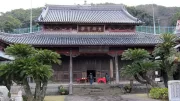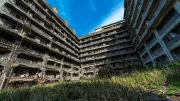Tucked between Nagasaki’s historic hills and just a short walk from the Dutch Slope and Dejima, the Confucius Shrine (孔子廟, Kōshi-byō) stands as one of the most unique cultural landmarks in Japan. Built in 1893 by the Chinese community of Nagasaki with support from the Qing Dynasty, it is one of only a few Confucian shrines in the world constructed by Chinese nationals outside China—and the only one that is directly administered by the Chinese government.

While most shrines and temples in Japan follow Shinto or Buddhist traditions, the Confucius Shrine honours the Chinese philosopher Confucius and the values of Confucianism: education, morality, and harmony. The grounds, designed in vibrant Chinese architectural style, feel distinctly different from Japanese religious sites—ornate red pillars, bright yellow roof tiles, and intricate carvings create a vivid, almost regal atmosphere.
The site includes a beautiful main hall with a statue of Confucius, surrounded by stone figures of 72 of his disciples. The peaceful courtyards and gardens offer a quiet retreat and a glimpse into Chinese aesthetics of the late Qing period.
Chinese History and Cultural Exchange
Behind the shrine, you’ll find the Historical Museum of China, showcasing artefacts and exhibits on Chinese history and the centuries-old trade and cultural relationship between China and Japan—particularly in Nagasaki, which served as Japan’s window to the outside world during the Edo period’s national isolation (sakoku).
The museum houses everything from Qing Dynasty scrolls to porcelain, old maps, religious items, and relics from ancient Chinese dynasties, making it a fascinating spot for history buffs.
Visiting Information
- Hours: Typically open daily from 9:30am to 5:00pm
- Admission: Modest fee (usually includes access to the museum)
- Photography: Permitted in most outdoor areas, but check signage for interior spaces
What’s Nearby
The Confucius Shrine is located in the Higashiyamate area, just a short stroll from other major sites like:
- The Dutch Slope: A scenic hill with preserved Western-style residences from the late 1800s
- Dejima: A restored former Dutch trading post that served as Japan’s only point of contact with the West for over 200 years
- Nagasaki Chinatown: One of the oldest in Japan, filled with local Chinese eateries and lantern-lit streets
This cluster of attractions makes for a pleasant half-day of cultural exploration—perfect for those interested in the layers of foreign influence in Nagasaki.
Access
- Tram: Take the Nagasaki Electric Tramway to Ourakaigandori or Shinchi Chinatown stop. The shrine is a 5–10 minute walk from either.
- On Foot: It’s easily reachable on foot from Chinatown, Dejima, or the Dutch Slope.




